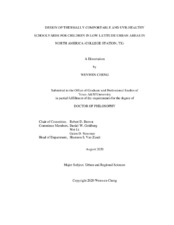| dc.contributor.advisor | Brown, Robert D | |
| dc.creator | Cheng, Wenwen | |
| dc.date.accessioned | 2021-01-29T17:27:08Z | |
| dc.date.available | 2021-01-29T17:27:08Z | |
| dc.date.created | 2020-08 | |
| dc.date.issued | 2020-07-29 | |
| dc.date.submitted | August 2020 | |
| dc.identifier.uri | https://hdl.handle.net/1969.1/192223 | |
| dc.description.abstract | Designing a thermal comfortable and ultraviolet radiation (UVR)-safety outdoor environment is essential to children to spend more time outdoor avoiding childhood obesity and the prospect of a range of other diseases in adulthood.
This dissertation consists of three articles. The first article modified the validated thermal comfort model, COMFA to consider the heat exchange of a child. Results shows that the actual thermal sensation responses from children and the predicted thermal sensation using the model is positively significantly related. The accuracy of the model is 93.26%.
The second article develops a method of integral calculation using field measured six- directional UVR data and the estimated body exposure ratio (ER) in the open area. This method shows high agreement when comparing with a validated formula using the ambient UVR and estimated ER data, with a high r-square (90.25%), and a low mean squared error (2.4%). Besides, this study confirms the conclusions from previous studies that using a personal dosimeter would underestimate the real individual UVR exposure.
The third article conducted an overview to assess the thermal and UVR healthy condition of eight schoolyards in College Station, Texas during different seasons. Based on the results, only the center points of artificial canopies, and the clustered trees in summer were found to provide effective shade. Test days in different seasons, canopy shade characteristics, ground material, protection factor, and the fraction of free sky from the southern direction were correlated with personal UV receipt. In summer in College Station, the heat condition is more severe than is the issue of too much UVR; in winter, more attention needs to be paid on insufficient UVR instead of being cold.
This paper provides a set of methods to evaluate children’s thermal comfort and individual UVR exposure in the landscape. It renders the microclimatic and UVR data on a wide temporal and geographical scale possible and opens broad perspectives for children’s thermal and UVR healthy study. Its application contributes to the children’s outdoor play areas design for landscape architectures and urban designers. | en |
| dc.format.mimetype | application/pdf | |
| dc.language.iso | en | |
| dc.subject | Microclimatic landscape design | en |
| dc.subject | children's thermal comfort | en |
| dc.subject | UVR exposure | en |
| dc.subject | schoolyard design | en |
| dc.title | Design of Thermally Comfortable and UVR-Healthy Schoolyards for Children in Low Latitude Urban Areas in North America (College Station, Tx) | en |
| dc.type | Thesis | en |
| thesis.degree.department | Landscape Architecture and Urban Planning | en |
| thesis.degree.discipline | Urban and Regional Science | en |
| thesis.degree.grantor | Texas A&M University | en |
| thesis.degree.name | Doctor of Philosophy | en |
| thesis.degree.level | Doctoral | en |
| dc.contributor.committeeMember | Goldberg, Daniel W | |
| dc.contributor.committeeMember | Li, Wei | |
| dc.contributor.committeeMember | Newman, Galen D | |
| dc.type.material | text | en |
| dc.date.updated | 2021-01-29T17:27:09Z | |
| local.etdauthor.orcid | 0000-0003-1160-0928 | |


